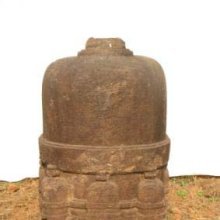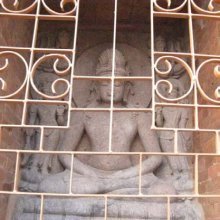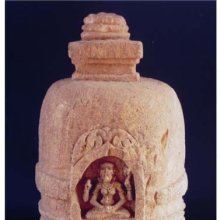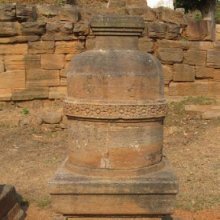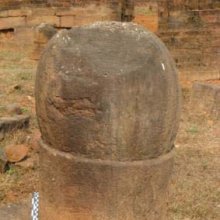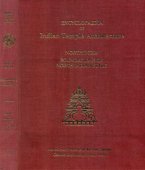Udayagiri, Udaya-giri: 12 definitions
Introduction:
Udayagiri means something in Hinduism, Sanskrit, the history of ancient India, Marathi. If you want to know the exact meaning, history, etymology or English translation of this term then check out the descriptions on this page. Add your comment or reference to a book if you want to contribute to this summary article.
Images (photo gallery)
(+35 more images available)
In Hinduism
Purana and Itihasa (epic history)
Source: archive.org: Puranic Encyclopedia1) Udayagiri (उदयगिरि).—The mountain of the rising. It is supposed by poets that the Sun and the Moon rise from this mountain.
2) Udayagiri (उदयगिरि).—An ancient place of pilgrimage. It is mentioned in Mahābhārata, Vana Parva, Chapter 84, Stanza 93, that by conducting evening prayer and devotion at this place once, one could obtain the fruits of conducting evening prayer and meditation for twelve years continuously.
Source: Cologne Digital Sanskrit Dictionaries: The Purana IndexUdayagiri (उदयगिरि).—A mountain the chief hill of Śākadvīpa.*
- * Viṣṇu-purāṇa II. 4. 62.

The Purana (पुराण, purāṇas) refers to Sanskrit literature preserving ancient India’s vast cultural history, including historical legends, religious ceremonies, various arts and sciences. The eighteen mahapuranas total over 400,000 shlokas (metrical couplets) and date to at least several centuries BCE.
Vastushastra (architecture)
Source: Knowledge Traditions & Practices of India: Architecture (1): Early and Classical ArchitectureUdayagiri.—The earliest Hindu caves, which belong to the early 5th century, are seen at Udayagiri, near Bhilsa in Madhya Pradesh.

Vastushastra (वास्तुशास्त्र, vāstuśāstra) refers to the ancient Indian science (shastra) of architecture (vastu), dealing with topics such architecture, sculpture, town-building, fort building and various other constructions. Vastu also deals with the philosophy of the architectural relation with the cosmic universe.
Jyotisha (astronomy and astrology)
Source: Wisdom Library: Brihat Samhita by VarahamihiraUdayagiri (उदयगिरि) or simply Udaya refers to a country (=mountain?) belonging to “Pūrvā or Pūrvadeśa (eastern division)” classified under the constellations of Ārdrā, Punarvasu and Puṣya, according to the system of Kūrmavibhāga, according to the Bṛhatsaṃhitā (chapter 14), an encyclopedic Sanskrit work written by Varāhamihira mainly focusing on the science of ancient Indian astronomy astronomy (Jyotiṣa).—Accordingly, “The countries of the Earth beginning from the centre of Bhāratavarṣa and going round the east, south-east, south, etc., are divided into 9 divisions corresponding to the 27 lunar asterisms at the rate of 3 for each division and beginning from Kṛttikā. The constellations of Ārdrā, Punarvasu and Puṣya represent the eastern division consisting of [i.e., Udayagiri] [...]”.

Jyotisha (ज्योतिष, jyotiṣa or jyotish) refers to ‘astronomy’ or “Vedic astrology” and represents the fifth of the six Vedangas (additional sciences to be studied along with the Vedas). Jyotisha concerns itself with the study and prediction of the movements of celestial bodies, in order to calculate the auspicious time for rituals and ceremonies.
India history and geography
Source: What is India: Annual Report on Indian Epigraphy (1945-1952)Udayagiri is an archaeologically important site situated in Bhilsa district (Madhya Bharat), known for inscriptions regarding the ancient history of India. For example, at Udayagiri there is a Sanskrit inscription in the Amṛta cave which records the renovation, possibly of a temple of Viṣṇu, by Kanha. Mentions also Chandragupta and Vikramāditya. It is dated V. S. 1093.
Source: Cologne Digital Sanskrit Dictionaries: Indian Epigraphical GlossaryUdaya-giri.—(IA 22), the mythical Sun-rise mountain. Note: udaya-giri is defined in the “Indian epigraphical glossary” as it can be found on ancient inscriptions commonly written in Sanskrit, Prakrit or Dravidian languages.

The history of India traces the identification of countries, villages, towns and other regions of India, as well as mythology, zoology, royal dynasties, rulers, tribes, local festivities and traditions and regional languages. Ancient India enjoyed religious freedom and encourages the path of Dharma, a concept common to Buddhism, Hinduism, and Jainism.
Languages of India and abroad
Marathi-English dictionary
Source: DDSA: The Molesworth Marathi and English Dictionaryudayagiri (उदयगिरि).—m (S) udayācala m (S) The eastern mountain behind which the heavenly bodies are supposed to rise.
Marathi is an Indo-European language having over 70 million native speakers people in (predominantly) Maharashtra India. Marathi, like many other Indo-Aryan languages, evolved from early forms of Prakrit, which itself is a subset of Sanskrit, one of the most ancient languages of the world.
Sanskrit dictionary
Source: DDSA: The practical Sanskrit-English dictionaryUdayagiri (उदयगिरि).—the eastern mountain behind which the sun, moon &c are supposed to rise; उदयगिरिवनालीबालमन्दारपुष्पम् (udayagirivanālībālamandārapuṣpam) Udb.; श्रितोदयाद्रेरभिसा- यमुच्चकैः (śritodayādrerabhisā- yamuccakaiḥ) Śiśupālavadha 1.16; तत उदयगिरेरिवैक एव (tata udayagirerivaika eva) Mālatīmādhava (Bombay) 2.1.
Derivable forms: udayagiriḥ (उदयगिरिः).
Udayagiri is a Sanskrit compound consisting of the terms udaya and giri (गिरि). See also (synonyms): udayācala, udayādri, udayaparvata, udayaśaila.
Source: Cologne Digital Sanskrit Dictionaries: Cappeller Sanskrit-English DictionaryUdayagiri (उदयगिरि).—[masculine] the eastern mountain, behind which the sun rises (cf. asta).
Source: Cologne Digital Sanskrit Dictionaries: Monier-Williams Sanskrit-English DictionaryUdayagiri (उदयगिरि):—[=ud-aya-giri] [from ud-aya > ud-i] m. the eastern mountain (See above), [Hitopadeśa; Viṣṇu-purāṇa etc.]
[Sanskrit to German]
Sanskrit, also spelled संस्कृतम् (saṃskṛtam), is an ancient language of India commonly seen as the grandmother of the Indo-European language family (even English!). Closely allied with Prakrit and Pali, Sanskrit is more exhaustive in both grammar and terms and has the most extensive collection of literature in the world, greatly surpassing its sister-languages Greek and Latin.
Kannada-English dictionary
Source: Alar: Kannada-English corpusUdayagiri (ಉದಯಗಿರಿ):—[noun] the eastern mountain behind which the sun, moon, and stars appear to rise from.
Kannada is a Dravidian language (as opposed to the Indo-European language family) mainly spoken in the southwestern region of India.
See also (Relevant definitions)
Starts with: Utayakiri.
Ends with: Utayakiri.
Full-text: Udyadgiri, Udayacala, Udyatparvata, Udayashaila, Udayadri, Udayaparvata, Udayakudhara, Udayorvibhrit, Udayaparvvata, Udyant, Anvarthopama, Anugatartha, Udaya, Sathuragiri, Pattacitra, Bhubaneswar, Kalinganagara, Pataliputra.
Relevant text
Search found 35 books and stories containing Udayagiri, Udaya-giri; (plurals include: Udayagiris, giris). You can also click to the full overview containing English textual excerpts. Below are direct links for the most relevant articles:
Jainism in Odisha (Orissa) (by Ashis Ranjan Sahoo)
Jaina Vestiges at Udayagiri and Khandagiri (Introduction) < [Chapter 8]
Light and Sound show Programme at Udayagiri ad Khandagiri < [Chapter 8]
Tourist influx in Udayagiri and Khandagiri < [Chapter 8]
The Devi Bhagavata Purana (by Swami Vijñanananda)
The history of Andhra country (1000 AD - 1500 AD) (by Yashoda Devi)
Part 13 - Yammaraja alias Nandivarma Maharaja (A.D. 1102) < [Chapter XII - The Pallavas]
Part 11 - The Pallavas of Nellore (A.D. 1050-1300) < [Chapter XII - The Pallavas]
Part 12 - Doraparuju (A.D. 1050-1102) < [Chapter XII - The Pallavas]
Stupas in Orissa (Study) (by Meenakshi Chauley)
Introduction < [Chapter 1]
Previous Research and Scope for Further Work < [Chapter 1]
Sahitya-kaumudi by Baladeva Vidyabhushana (by Gaurapada Dāsa)
Text 2.33 < [Chapter 2 - The Natures of Words (śabda)]
Yoga Vasistha [English], Volume 1-4 (by Vihari-Lala Mitra)
Chapter CXXIV - Quadripartite state of the king vipaschit < [Book VII - Nirvana prakarana part 2 (nirvana prakarana)]
Chapter xxxvi < [Book III - Utpatti khanda (utpatti khanda)]
Related products
